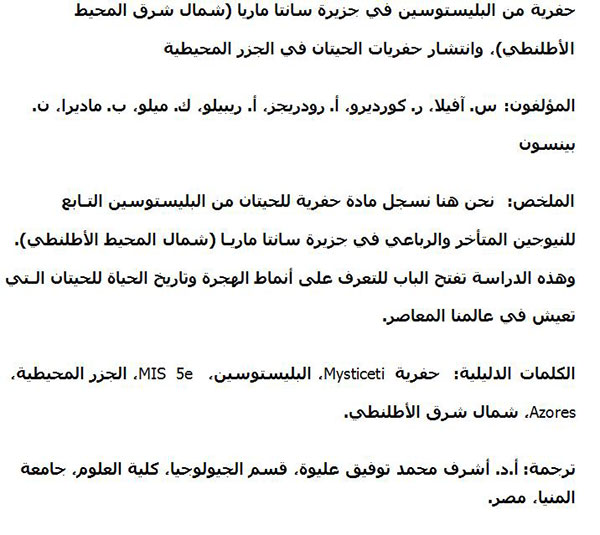Fossil Mysticeti from the Pleistocene of Santa Maria Island, Azores (Northeast Atlantic Ocean), and the prevalence of fossil cetaceans on oceanic islands
Plain Language Abstract
Cetaceans are common in the waters around volcanic oceanic islands. The Azores archipelago is a group of nine islands located in the NE Atlantic Ocean. For over a century, these islands were one of the most important sites in the whorl for land-based whale hunting. Nowadays, this activity was replaced by a growing and very important whale-watching tourism industry. Twenty-eight living cetacean species have been reported in the surrounding waters of the Azores.
Santa Maria is a volcanic oceanic island located in the archipelago of the Azores (NE Atlantic Ocean). This small island has an outstanding fossiliferous content, which is related with a complex and rare geological history: the first island emerged at about 6 Ma and for the next two million years it subsided at a rate of about 100m/Ma, disappearing under water and becoming a large submarine bank with a flat top - a guyot, as marine geologists call it - where thousands of marine organisms (including whales, sharks and many invertebrates) died and got entrained on the sediments. A new volcanic phase was responsible for the re-emergence of the island. During the last 3.5 Ma, the island has been uplifted for about 230 m so that today many outcrops with abundant fossil content are visible inland and along the shores of the island.
This paper reports the world’s second record of a fossil cetacean from the Last Interglacial (Pleistocene age). We should stress that in over 20,000 oceanic islands on our planet, to the best of our knowledge, remains of fossil cetaceans have only been reported from the Neogene of Miyako Island (Japan), the Mio-Pliocene of Santa Maria Island (Azores), the Pliocene of the Balearic Islands, and the Pleistocene of Nauru Island and again of Santa Maria Island, thus attesting the rarity of such fossils in volcanic oceanic islands!
Resumen en Español
Mysticeti fósiles del Pleistoceno de la Isla Santa María, Azores (Océano Atlántico Norte), y la prevalencia de cetáceos fósiles en islas oceánicas
Los restos fósiles de Cetacea son globalmente conocidos de sedimentos marinos ribereños (de nearshore) a lo largo de líneas de costa continentales, pero son pobremente conocidos en archipiélagos de islas volcánicas oceánicas. Aquí, informamos acerca de material pleistoceno de cetáceos fósiles de afloramientos de edad neógena tardía y cuaternaria de la Isla Santa María del archipiélago de las Azores en el Océano Atlántico Norte. Estos restos consisten de un fragmento aislado y altamente erodado de la mandíbula de un misticeto barbado de tamaño mediano a grande (i.e., Chaeomysticeti), el cual fue expuesto en el nivel del estadio isotópico marino 5 (subestadio MIS 5e) en Praia do Calhau, luego de que el huracán Gordon golpeara la isla de Santa María en agosto del 2012. Mientras que este caso representa solamente la segunda descripción de cetáceos pleistocenos de islas volcánica oceánicas, predecimos que los cetáceos fósiles son probablemente sub-informados en islas oceánicas, dada su abundancia y riqueza actual cerca de archipiélagos de islas cuya geomorfología y oceanografía proveen importantes escenarios para la migración y patrones de historia de vida de los cetáceos actuales.
Palabras clave: Mysticeti fósiles; Pleistoceno; MIS 5e; islas oceánicas; Azores; Atlántico NE
Traducción: Diana Elizabeth Fernández
Résumé en Français
Mysticeti fossiles du Pléistocène de l'île de Santa Maria, Açores (océan Atlantique Nord-Est) et la fréquence des cétacés fossiles sur les îles océaniques
Des restes fossiles de Cetacea sont connus dans les sédiments marins le long des littoraux continentaux du monde entier, mais ils sont mal représentés dans les archipels océaniques volcaniques. Nous présentons dans cet article du matériel fossile pléistocène de cétacé provenant d'affleurements datant du Néogène récent et du Quaternaire sur l'île de Santa Maria (archipel des Açores, océan Atlantique Nord). Ce matériel comprend un fragment de mandibule isolé et fortement usé appartenant à un mysticète de taille moyenne à grande (Chaeomysticeti). Il a été découvert dans le niveau du stade isotopique marin 5 (sous-stade SIM 5e) à Praia do Calhau, après que l'ouragan Gordon a frappé l'île de Santa Maria en août 2012. Bien que ce ne soit que la deuxième description de cétacés pléistocènes provenant d'îles océaniques volcaniques, nous prédisons que les cétacés fossiles sont probablement communs sur les îles océaniques, et ce en raison de leur abondance et leur richesse à proximité des archipels océaniques actuels. La géomorphologie et l'océanographie de ces archipels constituent en effet des cadres importants pour les schémas de migrations et d'histoire de vie des cétacés actuels.
Mots-clés : Mysticeti fossiles ; Pléistocène ; SIM 5e ; îles océaniques ; Açores ; Atlantique Nord-Est
Translator: Antoine Souron
Deutsche Zusammenfassung
Fossile Mysticeti aus dem Pleistozän der Santa Maria Insel, Azoren (nordöstlicher Atlantik) und die Verbreitung fossiler Cetacea an ozeanischen Inseln
Fossile Überreste von Cetacea sind weltweit von küstennahen marinen Sedimenten entlang der kontinentalen Küstenlinien bekannt, von ozeanischen Vulkaninseln dagegen jedoch nur wenig. Hier berichten wir über pleistozänes Cetacea-Fossilmaterial aus dem späten Neogen und Quartär der Santa Maria Insel (Azoren) im Nordatlantik. Die Überreste bestehen aus einem isolierten und stark verwitterten Unterkieferfragment eines mittelgroßen bis großen bartentragenden Mysticeten (i.e., Chaeomysticeti), das im marinen Isotopenstufe 5 (Unterstufe MIS 5e)-Niveau in Praia do Calhau freigelegt worden war, nachdem der Hurrikan Gordon im April 2012 die Santa Maria Insel getroffen hatte. Obwohl dieser Fund erst die zweite Beschreibung eines pleistozänen Cetacea von ozeanischen Vulkaninseln ist, prognostizieren wir, dass fossile Cetacea möglicherweise an ozeanischen Vulkaninseln unterrepräsentiert sind wenn man von ihrer heutigen Häufigkeit und Fülle in der Nähe von ozeanischen Vulkaninseln ausgeht, deren Geomorphologie und Ozeanographie eine wichtige Umgebung für die Migration und die Lebensgewohnheiten von heute lebenden Cetacea darstellt.
Schlüsselwörter: fossile Mysticeti; Pleistozän; MIS 5e; Ozeaninseln; Azoren; Nordostatlantik
Translator: Eva Gebauer
Arabic

Translator: Ashraf M.T. Elewa

